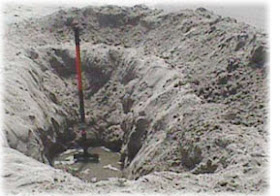With the growth of industry comes pollution. With
pollution comes contaminated water.
Can the old basic filtration methods still
produce the best drinking water?
Or, do we need more intense purification methods to
combat the modern contaminants in our water supply? The answer is probably the
latter.
But let's discuss the traditional filtration methods
first. These basic traditional methods can include many options, with the two
most prevalent being boiling and chemical.
Although effective in ridding water of some things, we
will show you that these methods still leaves behind harmful materials in the
water.
Traditional Water Purification Methods
1. Boiling
Historically, boiling is what has been used
to disinfect water from microorganisms. In fact, when done correctly, it can
kill most bacteria, but not all. Bacteria and protozoa are killed at the first
bubble, and it takes about three minutes to kill the rest.
The drawbacks to this purification method:
·
it can require lots of fuel and
cooking equipment.
·
water cannot be used immediately, as
it needs to cool down.
·
since the boiling water is so hot,
some of the water may evaporate before its use.
·
the water can still contain particles.
So further filtering through a handkerchief could be necessary.
·
Finally, boiling water does not
eliminate chemical pollutants
(including chlorine), poor taste
of foul odors, and in fact can leave a stale taste.
Boiling water may be the only method during
situations like camping, but in a household, there are more effective and
efficient methods available.
2. Chemical
There are two primary chemicals used to
purify water: iodine and chlorine. Both are lightweight, low cost and easy to
use.
- Iodine
has been proven effective in killing off viruses, bacteria and protozoa. However,
the colder the water is, the more time it will take to purify with iodine.
Iodine can also absorb into the dirt and debris naturally
found in water, so the dosage will always vary.
Also, pregnant women or those with thyroid conditions
should not drink water with the chemical.
Usually, iodine is just used for short-term purposes, and
should not be used for more than three consecutive months. Many do not favor
the taste it leaves behind either.
The unfavorable taste can be combated by mixing the water
with a sugar-based drink mix, or better yet, by not using the method at all.
- Chlorine bleach is the second chemical
purifier. The process of chlorination will
cause dirt and debris to settle to the bottom of the water container and make
the water visually clearer.
The American Red Cross endorses the brand Chlorox. The
Red Cross states that people should use an unscented household bleach that
contains 5.25% sodium hypochlorite.
When using bleach to purify, the recommendation is to add
16 drops of bleach per gallon of water, stir, and let stand for 30 minutes. If
the water does not have a slight bleach odor, repeat the dosage and let stand
another 15 minutes.
There are many drawbacks to the chlorination method. If
the household bleach is over six months old, it may not have enough potency to
disinfect.
 Also, chlorine is very poisonous and adding too much can
cause illness, internal organ damage or even death.
Also, chlorine is very poisonous and adding too much can
cause illness, internal organ damage or even death.
Chlorine has been linked to many health problems.
Also, if one decides to use bleach, be sure to add it at
the time intended to use the water, not when storing.
Seeing the drawbacks of these traditional filtration
methods brings us to understand why more advanced water purification are
required nowadays.
Advanced Modern Water Purification Methods
Water filtration by definition simply means
to strain out the impurities from a water source. The larger the impurity
particulate, the easier it is to filter. The opposite is true: the smaller the
impurity particulate, the harder it is to remove.
Thus, the size of the filter pore and the durability of
the filtering element are important to the filter's longevity and its ability
to perform. Most filtering elements are made of ceramic, glass fiber,
hard-block carbon, or materials that resemble compressed surgical paper.
 |
| Highly-Activated Carbon |
Some of the better purification methods
include the activated carbon and reverse
osmosis.
The best contribution that carbon makes to filtration
technology is its ability to reduce chemical quantities, poor taste, odors and
many pollutants.
Because carbon is only mildly effective in filtering out
particulates and microorganisms, it is mostly used as a second or third stage
filter in home and portable water use.
It is seldom used as a stand-alone filtering, and often
times, used in conjunction with reverse osmosis.
Reverse osmosis uses a semi-permeable membrane filter to
separate the water from contaminants.
 |
| Reverse Osmosis with Steel Tank and Cartridge Pre-Filters |
Reverse
osmosis is highly effective in removing several impurities from water such as total
dissolved solids, turbidity, asbestos, lead and other
toxic heavy metals, radium, and many
dissolved organic matter.
The process will also remove chlorine, and nuclear
radiation particles such as radioactive plutonium and strontium
in the drinking water.
Reverse osmosis combined with activated
carbon seems to be the most advanced water purification method developed so
far.
Reverse Osmosis
https://www.freedrinkingwater.com/water-education/quality-water-purification.htm





















